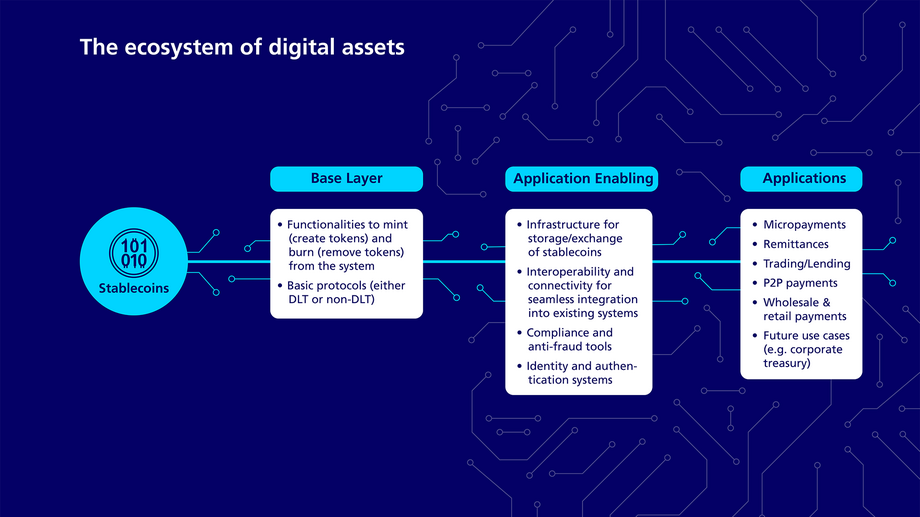Crypto-assets are making headlines pretty much every single day. But amidst hundreds of new, highly volatile crypto-assets launched every year,1 there are plenty of less volatile crypto-assets worthy of our attention: stablecoins. Here, the market volume has grown from $6 billion in 2020 to $170 billion in 2022.2

Seeking stability in the crypto space: are stablecoins the answer?
The past couple of years have shown the rapid rise of a new crypto-asset – stablecoins – with the market volume growing rapidly.
Stablecoins aim “to maintain a stable value relative to a specific asset.”3 They can be backed by fiat currencies, by commodities (gold, silver, oil, etc.), by crypto-assets such as Bitcoin or Ether, or by algorithmic mechanisms, relying on market mechanics to keep their price stable.
With central bank digital currencies (CBDCs) in development across the globe, the digital asset ecosystem has never been more complex or more diverse.
G+D partners with central banks to help develop CBDCs, and as a technology leader in all spheres of payment, is developing its expertise across the payment landscape. In 2020, G+D Ventures invested in the cryto custody company METACO. Custody of digital assets is an integral part of creating trust in the crypto-asset ecosystem – and that applies to CBDCs too.
To some it might seem that stablecoins could potentially offer advantages similar to those of CBDCs. So what are the differences between stablecoins and CBDCs, apart from their issuers? What is the potential of stablecoins, particularly compared with other digital assets? How could these crypto-assets develop in the future? Andreas Barthelmes, Associate at G+D Ventures, offers insights into the rapid rise of stablecoins and explains what the future might hold.
The differences between CBDCs and stablecoins
Put simply, a CBDC is a central-bank-issued digital currency, while stablecoins are usually privately issued. But there’s more to it than that, as Barthelmes explains: “A stablecoin is not universal in its acceptance, as a CBDC would be. Each player would have to decide whether to trust and accept it as a form of payment. Central bank digital currencies, on the other hand, would be a legal tender with wide to universal acceptance.” Another important aspect is the issue of trust, says Barthelmes. “Stablecoins are based on a very secure system (usually a blockchain),” he explains, “but at the same time, you often don’t know who is behind it and where potential flaws in the system could lie. From a backing perspective, CBDCs are a liability to the central bank – which holds a great deal of public trust. The backing of stablecoins is guaranteed by most private issuers, which in theory can be almost anybody.”
And then there’s a difference in market readiness. “With stablecoins, there’s been a fast time to market, partly due to the private issuers being more willing to take risks, while central banks – with good reason – require a longer time to market,” continues Barthelmes. “Reasons are that CBDCs will have offline functionalities and other ecosystem integrations to make it a trustworthy complement to cash. Currently, central bank digital currencies are largely in an early pilot stage, with the only larger live project currently in China. Meanwhile, stablecoins already have a large volume in the market.” In contrast to stablecoins, CBDCs will also add additional benefits for society, such as guaranteeing financial inclusion.
“In my opinion, stablecoins are global by design. Based on DLT technology, cross-border transactions are easier, lower-cost than at present, and no cross-border conversions are needed. On the other hand, from a regulatory and taxation perspective, cross-border transactions with stablecoins are a potential problem“
Associate at G+D Ventures
Stablecoins in use
The world of crypto-assets can be confusing, so let’s take a look at stablecoins in practice. Where are they being used? What are the challenges faced?
Barthelmes’s research found that “what we see in the market right now is usage for investment purposes. It’s more of a stable crypto-asset compared with Bitcoin, etc., and many investors have decided to realize profits by converting their highly volatile crypto-assets into stablecoins. But there are more interesting use cases ahead for stablecoins, both in the crypto world (e.g. for decentralized finance projects) and in the real world (e.g. for merchant or B2B payments).”
Perhaps the best publicly known stablecoin is Diem (formerly Libra), by a consortium of companies including Mark Zuckerberg’s Meta (formerly Facebook), announced in 2019. Facing regulatory hurdles and commercial backlash, the project folded in February 2022. In 2021, Visa announced that it is working to accept some stablecoins to use for payment processing. Mastercard is working on a similar project. In early January 2022, PayPal confirmed rumors that the company was exploring stablecoins. With financial institutions exploring these new payment options, the burgeoning world of stablecoins is entering mainstream applications. Nevertheless, challenges are – as Diem demonstrates – abundant.
The state of stablecoins
While stablecoins are a sturdier alternative to traditional crypto-assets, they’re not without their disadvantages. “They offer low consumer protection, a risk to monetary sovereignty, and money-laundering issues,” says Barthelmes. “Finally, unclear regulation remains in many countries.”
Stablecoins are usually based on DLT technology, a decentralized database of transactions that ensures security, transparency, and privacy. The technical basis of CBDCs could potentially be quite similar, but it doesn’t have to be.

The future: a look into the crypto ball
Barthelmes summarizes: “The main issue with stablecoins is still trust – but mechanisms to ensure trust can make stablecoins competitive in the future, whilst CBDCs have that trust already in-built.”
Stablecoins have been an eye-opener for central banks looking to develop a digital currency for mass use. It is entirely possible that CBDCs and stablecoins will be able to coexist in the future, as the two have very different value propositions, with CBDCs focusing on everyday retail use. When CBDCs enter the market, we will see how the two can coexist as a new means of payment in the long run.
Published: 17/03/2022
Share this article
Subscribe to our newsletter
Don’t miss out on the latest articles in G+D SPOTLIGHT: by subscribing to our newsletter, you’ll be kept up to date on latest trends, ideas, and technical innovations – straight to your inbox every month.


